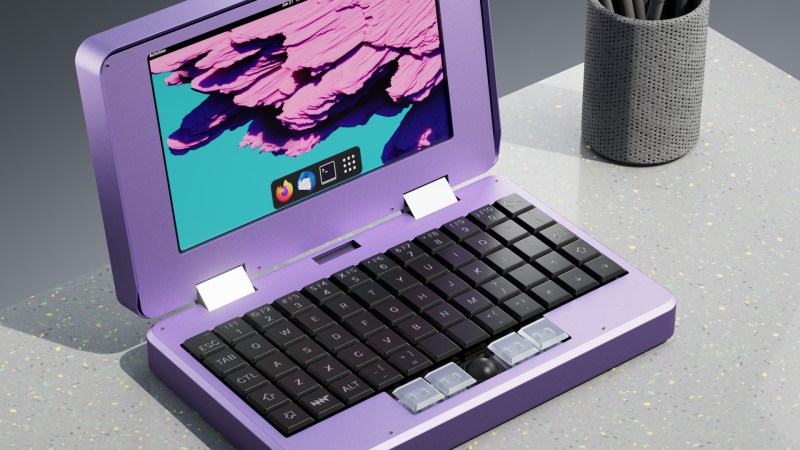You might have already seen the pretty pictures in pastel colors online — a small netbook-like computer with a full-size keyboard. This, while a render, is what the MNT Pocket Reform is going to look like. Reminiscent of the netbook aesthetic in all the right ways, it’s a small device with a mechanical keyboard taking as much space as possible, trackball for navigation, and we assume, exactly the kind of screen that’d be comfortable to use.
We’ve reviewed the MNT Reform a year ago, and this device inherits a lot of its good parts. The motherboard’s connectivity is likely subject to change, but on the motherboard renders, we can spot three USB-C ports, a Micro HDMI port, a microSD card slot, ix Industrial Ethernet, and M.2 B-key and M-key slots for WWAN and SSD cards respectively.
If you expected computational specs, there isn’t really a specific CPU+RAM configuration announced – for a good reason. The Pocket Reform takes advantage of the CPU card concept designed into the MNT Reform – able to take a card with an NXP i.MX8M CPU, Raspberry Pi CM4, Pine SOQuartz, a Kintex-7 FPGA, or any of the cards yet to be developed. The design files are open-source, the prototype motherboards have been ordered, mechanical usability aspects have been worked through. This is a very compelling project, and we can’t wait to see it bear fruit!
MNT Pocket Reform is coming! (more info below) pic.twitter.com/c6g4GG2Nif
— lukas f. hartmann (@minut_e) June 27, 2022
















Looks neat, but if its going to be over $1,000, then it simply won’t be worth buying.
I’m still waiting for the original MNT reform which I ordered on Crowdsupply on 27th October 2020 and I don’t have it yet.
So I’m a bit afraid how much I would have to wait for this one.
I order Pygo 1 (2 device) and still not get ;(
yes, kickstarter is hard
I’d love to get another modern ultra portable. However all vendors seem to agree that crippling the keyboard is an acceptable trade off for the customer. The way I see it the keyboard ratio doesn’t match the standard 16:9 screen ratio. A custom screen wont do (for some reason) and the two halves have to fit when the lid is closed somehow. That’s probably why they all take a hacksaw and cut off 20% of the keyboard. No 10 Finger typing for the user then.
The last vendor that understood the issue was sony with the discontinued Vaio P11. Got two of those and would have redone the PCBs with a RPI CM4 if the screen was actually compatible to any available converter IC out there. (proprietary INTEL only LVDS signal)
I used to have a PCG-C1F, and it was an excellent ultraportable. Unfortunately the LCD met a leaky end when it overheated in a car under Spanish sun.
Neat machines, but they also had cramped keyboards, and too-high resolution screen for the size, for the time. Trackpoint was nice though.
A 5×12 ortho layout is hardly “crippling”. Many, many people who care deeply about keyboards go smaller than this still. Central to the concept is making extensive use of interesting modifiers, time-based behaviours, etc to get more out of fewer keys. Fewer keys means less hand movement, means higher efficiency and comfort.
Lol i use a planck, and I type with 10 fingers. I can’t wait for this device
The 1990’s called; they want their design aesthetic back.
Brace yourself, 90s retro about to explode.
90s is retro now?
Ok
(waiting for 2018 retro…)
I’m very excited by this thing. I have spent way too long doodling my dream netbook, then redesigning it to suit the new pi4 compute module, then thinking maybe the pi zero 2 would be better, then going down the rabbit hole of using a blackberry keyboard, then trying to find a nice high res screen… This MNT machine might just give me enough flexibility to do the job, especially if a nice ecosystem of open-source accessories build up…